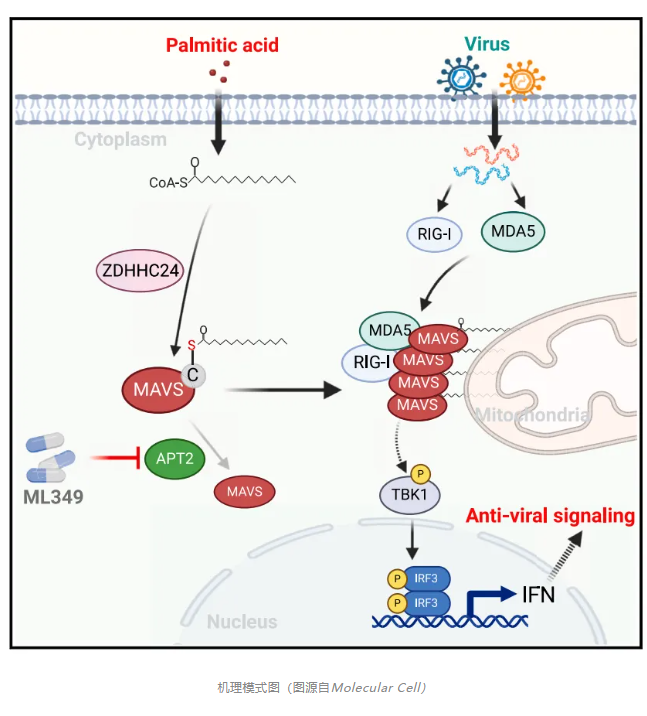11
2024
-
09
The latest research by Guo Jianping/Cheng Chao/Bo Lang of Sun Yat-sen University confirms that palmitic acid can suppress virus infection by activating innate immunity!
Author:
Innate immunity is the primary defense against viral and microbial infections. The exact effect of cellular metabolites, particularly fatty acids, on antiviral innate immunity remains largely elusive.
On September 9, 2024, Sun Yat-sen University Guo Jianping, Cheng Chao and Bo Lang jointly communicatedMolecular Cell(IF=14.5)Published online entitled“Targeting APT2 improves MAVS palmitoylation and antiviral innate immunity”The research paper,The study showedTargeting APT2 improves MAVS palmitoylation and antiviral innate immunity.
Here, palmitic acid (PA) has been identified as a key regulator of antiviral infection in human cells by screening a metabolite library. Mechanically, PA induces palmitoylation, aggregation and subsequent activation of the mitochondrial antiviral signaling protein (MAVS), thereby enhancing the innate immune response.Palmitoyltransferase ZDHHC24 catalyzes the palmitoylation of MAVS, thereby promoting the TBK1-IRF3 interferon (IFN) pathway, especially under conditions of PA stimulation or high-fat diet fed mouse models, leading to antiviral immune responses.In addition, APT2 de-palmitoylated MAVS, thereby inhibiting antiviral signaling, suggesting that its inhibitors, such as ML349, effectively reverse MAVS activation in response to antiviral infection.These findings highlight the critical role of PA in modulating antiviral innate immunity through MAVS palmitoylation and provide strategies to increase PA intake or target APT2 against viral infections.
In turn, it promotes the expression of IFNs-stimulated genes (ISGs) and enhances host resistance to viral and microbial infections. MAVS is a central receptor in this process and undergoes various post-translational modifications, including phosphorylation, ubiquitination, and palmitoylation, all of which regulate the expression of ISGs and contribute to anti-infection effects.Therefore, exploring upstream regulators of MAVS will provide alternative strategies to combat viral infections, including influenza, coronavirus, hepatitis C virus, etc.

LATEST NEWS
2024-09-16
Tsinghua University Xiao Bailong/Peking University Ouyang Kunfu Collaboration Reveals Key Phosphorylation Sites That Regulate Piezo1 Mechanical Sensitivity and Mechanotransduction Function in Vivo
Piezo1 is a mechanically activated cation channel that can convert mechanical forces into various physiological processes. Due to its large protein size of more than 2500 amino acids and complex 38 transmembrane helix topology, how Piezo1 is post-translationally modified to regulate its mechanotransduction function in vivo remains unexplored.
2024-09-18
Huazhong University of Science and Technology Wang Cong Yi/Sun Fei found in obese environment really pathogenic adipose tissue macrophage subsets
Adipose tissue macrophages (ATMs) play an important role in maintaining adipose tissue homeostasis and coordinating metabolic inflammation. Given the extensive functional heterogeneity and phenotypic plasticity of ATMs, there is a need to identify truly pathogenic subpopulations of ATMs in the context of obesity.
2024-09-14
Wang Su's team at Southeast University found that microenvironmental glial cells regulate stem cell self-renewal and differentiation by delivering iron to neural stem cells through ferritin
The study of neural stem cells is of great significance for the treatment of neural development and nervous system diseases. However, the regulation mechanism of neural stem cells has not been fully elucidated, especially the regulation of neural stem cells by microenvironment is relatively less known.
2024-09-14
Subversion of the past! Tsinghua University Dai Qionghai/Guo Zengcai/Wu Jiamin Cooperation Latest Cell
A comprehensive understanding of physiopathological processes requires non-invasive live three-dimensional (3D) imaging on different spatial and temporal scales. However, huge data throughput, optical non-uniformity, surface irregularities, and phototoxicity pose huge challenges, resulting in inevitable trade-offs between volume size, resolution, speed, sample health, and system complexity.
2024-09-11
The latest research by Guo Jianping/Cheng Chao/Bo Lang of Sun Yat-sen University confirms that palmitic acid can suppress virus infection by activating innate immunity!
Innate immunity is the primary defense against viral and microbial infections. The exact effect of cellular metabolites, particularly fatty acids, on antiviral innate immunity remains largely elusive.

